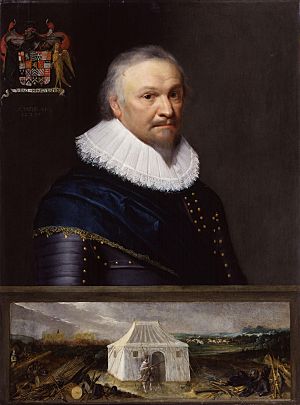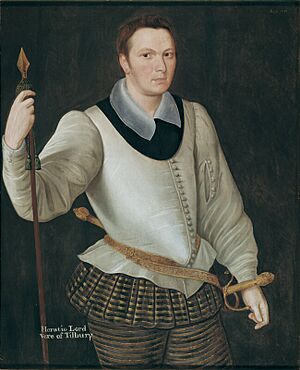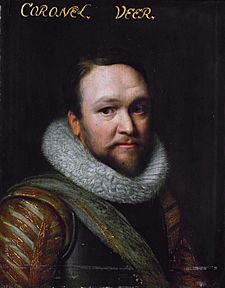Horace Vere, 1st Baron Vere of Tilbury facts for kids
Quick facts for kids
Horace Vere
Baron Vere of Tilbury
|
|
|---|---|

Portrait of Sir Horace Vere
|
|
| Personal details | |
| Born | 1565 |
| Died | 2 May 1635 (aged 69–70) Whitehall |
| Resting place | Westminster Abbey |
| Spouse | Mary Tracy |
| Parents |
|
| Relatives | De Vere family |
| Military service | |
| Conflicts |
|
Horace Vere (born 1565, died 1635) was a brave English military leader. He fought in two major wars: the Eighty Years' War and the Thirty Years' War. He was also known as Horatio Vere. Horace was the brother of another famous soldier, Francis Vere. King James I sent him to the Palatinate region in 1620. Later, he was given the special title of Baron Vere of Tilbury. He had no sons to inherit his title.
Contents
Family Life
Horace Vere was born in 1565. He was the fourth son of Geoffrey Vere. His mother was Elizabeth Hardekyn. Horace had three older brothers: John, Sir Francis, and Robert. He also had a sister named Frances. She married Sir Robert Harcourt.
Horace Vere's Military Career
Horace Vere was a skilled and respected soldier. He spent most of his life fighting in important battles. He became known for his bravery and leadership.
Fighting in the Anglo-Spanish War (1585-1604)
In 1590, Horace joined his brothers in the Netherlands. He served in the army under his brother, Sir Francis. In 1592, he was hurt during the attack on Steenwijk. This was a strong fortress.
Horace was recommended for a company at the siege of Groningen in 1594. He was knighted for his courage at the siege of Cadiz in 1596. This meant he became "Sir Horace Vere."
The next year, Horace took command of English forces in the Netherlands. He worked with Maurice of Orange. They captured several cities in the eastern Netherlands. These cities created an important barrier.
At the Battle of Nieuwpoort in 1600, Horace led 300 foot soldiers. He helped rally the English troops after his brother left the field. At the Siege of Ostend in 1602, he played a big part in stopping a Spanish attack. He was badly hurt in the leg.
After his brother Sir Francis was wounded, Horace took command of the English forces at the siege of Grave. In 1603, he delivered a message to the new king. When Sir Francis retired, Sir Horace took his place as a senior English commander in the Netherlands.
Serving the Dutch Army
In 1604, the Spanish captured Ostend. To balance this, Maurice of Nassau planned to retake Sluys. Vere helped dislodge a Spanish force at Damme. This was a very risky operation. Vere's command earned praise from the Dutch government. Sluys was surrendered in August 1604.
At the Battle of Mülheim in 1605, Vere showed great skill. He crossed a river with his infantry. He held off the Spanish for over an hour. This allowed other forces to regroup and retreat safely.
After this battle, Vere returned to England. He married in 1607. In 1609, he became the governor of Brielle. This was an important town. In 1610, he served at the siege of Juliers.
In 1616, England returned Brielle to the Dutch. Vere received a pension for losing his governorship. Two years later, he became the governor of Utrecht. He helped Prince Maurice put down local uprisings.
The Palatinate Campaign
In 1620, King James I was urged to help his son-in-law. His son-in-law was Frederick V, Elector Palatine, a Protestant leader. James I allowed volunteers to be raised. Sir Horace Vere was chosen to lead them.
Vere's plan was to join forces with a Protestant army near Mannheim. He marched his troops through difficult territory. He avoided a Spanish attempt to cut him off. Vere's forces finally met their allies in Worms.
Vere divided his troops among three strongholds. He took command of Mannheim. Other officers defended Heidelberg Castle and Frankenthal. In 1621, the Protestant alliance broke up. The English garrisons were left on their own.
In 1622, the dethroned elector visited Mannheim. He had won a small victory with his allies. However, the imperial army soon defeated the Protestants. The elector had to leave Mannheim.
Vere's garrisons were now surrounded. They faced large armies. Vere decided to hold out, even though it seemed hopeless. On September 16, Heidelberg was captured. The castle surrendered three days later.
At Mannheim, Vere had 1,400 men. They had no money or supplies. He had to defend large fortifications. He eventually surrendered at the end of September. He marched out with military honors. Vere's brave defense was celebrated in England.
He returned to England in 1623. He was appointed master-general of the ordnance for life. This was a very important military position.
Battles at Breda and Brabant
In 1624, Sir Horace Vere went to The Hague again. He helped Prince Maurice defend the fortress of Breda. The Spanish army was besieging it. Prince Maurice died in 1625. His brother, Frederick Henry, Prince of Orange, took over.
Frederick Henry decided to attack the siege works. Vere was chosen to lead this dangerous mission. On May 13, 1625, Vere led 6,000 men. They captured a redoubt after a fierce fight. However, the English were forced to retreat due to heavy losses.
When he returned to England, Vere was highly respected. He was made Baron Vere of Tilbury.
His next mission was the siege of 's-Hertogenbosch in 1629. This was a key military position. Many future famous soldiers served under Vere there. These included Thomas Fairfax and Philip Skippon. They later helped create the New Model Army.
Vere's service in the Netherlands ended with the Capture of Maastricht in 1632. He commanded a powerful brigade. Many were killed or wounded during these operations.
Death
After Maastricht, Vere returned to England. He died on May 2, 1635, while having dinner. He was buried with military honors. His tomb is in Westminster Abbey, shared with his brother, Sir Francis.
Marriage and Children
In 1607, Vere married Mary Tracy. She was a widow with two children. Horace Vere had five daughters with Mary. They were his only heirs, as he had no sons.
His daughters were:
- Elizabeth Vere, who married John Holles, 2nd Earl of Clare.
- Mary Vere, who married Sir Roger Townshend. She later married Mildmay Fane, 2nd Earl of Westmorland.
- Catherine Vere, who married Oliver St John. She later married John Poulett, 2nd Baron Poulett.
- Anne Vere, who married Sir Thomas Fairfax.
- Dorothy Vere, who married John Wolstenholme.
- Susana Vere, who died young.
Lady Vere, Horace's wife, lived until 1670. She was 90 years old. For a short time, she cared for the king's children.
Horace Vere was a cousin of Edward de Vere, 17th Earl of Oxford.



